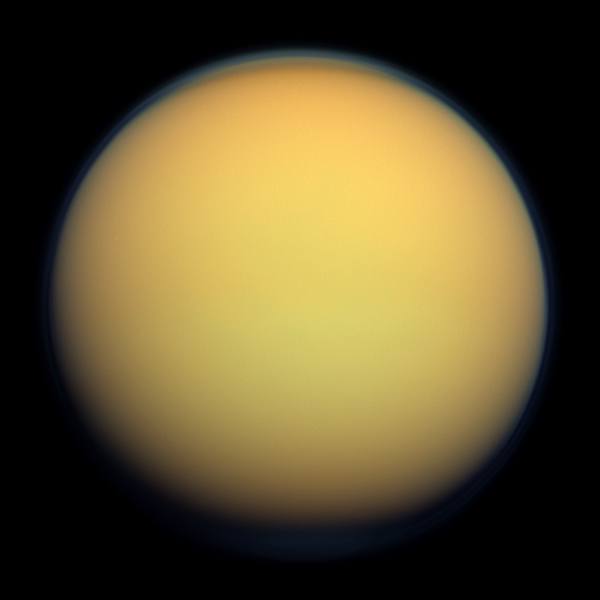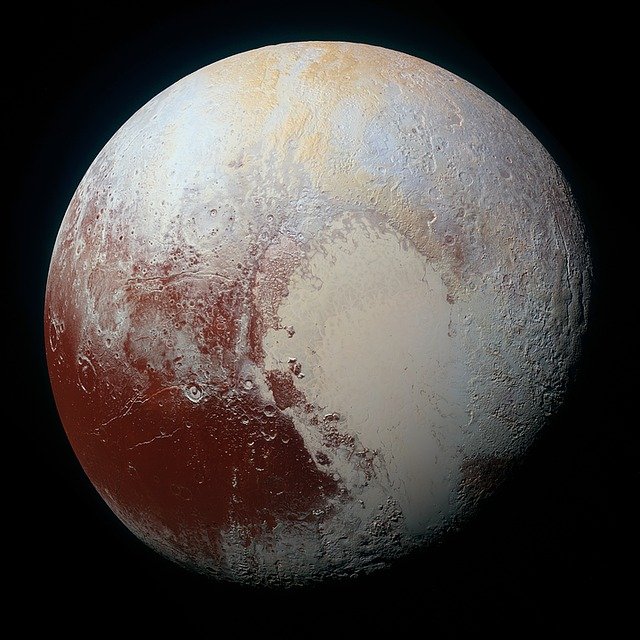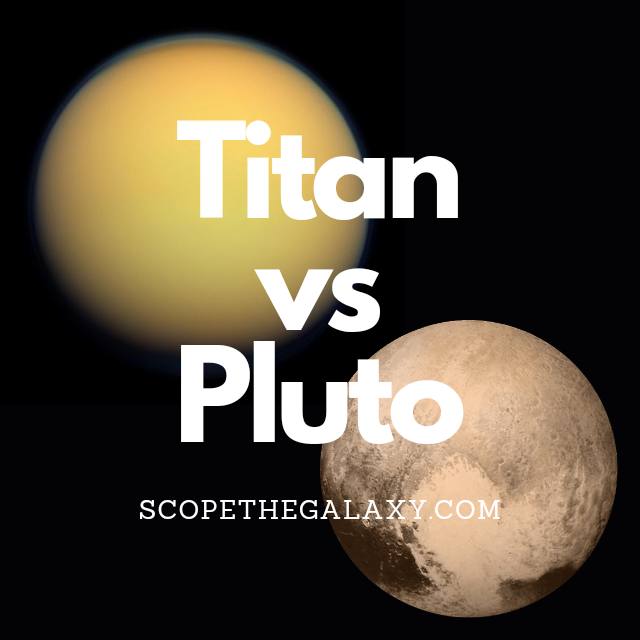*This post may contain affiliate links. This means we may make a commission if you purchase an item using one of our links*
The main differences between Titan and Pluto is that Pluto is a dwarf planet with a diameter of 2,370km with 5 moons orbiting it whilst Titan is the 2nd largest moon in our solar system that orbits Saturn, is more than twice Pluto’s size with a diameter of 5,150km and has a surface brimming with water as it follows a water cycle similar to Earth’s.
There are numerous other differences and the odd few similarities between these two celestial objects so, continue reading for a more thorough breakdown of each entity below.
What Is The Moon Titan?
Table of Contents

Titan is Saturn’s largest moon and the second biggest moon in the entire solar system, with a diameter of 5,150km. This would make it even larger than the planet Mercury which is only 4,879km, and significantly larger than Pluto also.
As a result, Titan’s gravitaional strength stands at around 1.352 m/s²
It is the only natural satellite in our solar system that is composed similarly to Earth, where it has a thick atmosphere made primarily of nitrogen (95%) along with smaller amounts of methane (5%). It has rivers and lakes on its surface along with a water cycle very similar to that of Earth, where essentially water evaporates and eventually lands on the satellites surface.
Therefore, much like Earth, Titan has a terrestrial based body but, there is a difference in their atmospheric pressure. The pressure on Titan’s surface is around 60% greater than that of Earth’s surface but, it isnt nearly as dense.
Nevertheless, it is still far denser than most other bodies at 1.88 g/cm³. As a result, Titan’s mass is 1.345×10^23 kg.
In regards to its temperature, Titan is on the colder side where it averages around -179 degrees Celsius whilst its core’s temperature is actualluy very cold in comparison to other entities falling between 226 – 526 degrees Celsius.
As Saturn is the 6th farthest planet from the Sun, it will take Titan roughly the same amount of time to orbit the Sun, which would fall around 29.4 years.
It takes Titan 15 days and 22 hours to orbit Saturn. A day is 15 days and 22 hours also as it is tidally locked to the gas giant.
What Is The Dwarf Planet Pluto?

In the past Pluto was the 9th farthest official planet in our solar system however, in 2006 after many debates between astronomers, the International Astronomical Union officially downgraded it to a dwarf planet.
The reason for this downgrade at the time was primarily down to Pluto simply being very small when compared to every other planet and even the moons orbiting these planets. Pluto’s dwarf status is debated still to this day but, for now it still remains under this dwarf bracket for a planet
Its diameter for example is only 2,370km, which is a third of Earth’s Moon. With that being said, despite the significant size discrepancy Pluto shows, it still does have more moon like objects orbiting it than Earth and I’m not saying just one more.
In total this terrestrial dwarf planet has 5.
Pluto’s atmosphere consists mostly of molecular nitrogen whilst molecules of methane and carbon monoxide have been observed also. As for its surface, it consist mostly of frozen nitrogen, methane, and carbon monoxide ices.
One of Pluto’s most unique characteristic is that Charon (its largest moon) is tidally locked to it and vice versa, which means that the two essentially orbit each other.
In essence only one side of Charon and one side of Pluto surface will face each other at any given time.
Pluto’s temperature is between -222 to -232 degrees Celsius based on how close it gets to the Sun when orbiting it, whilst its core temperature isn’t anything too special sitting around 500 – 1,000 degrees Celsius.
The main reason it’s as cold as it is and has a relatively cold core in comparison to the other planets would be, which is mostly down to its size. A larger size would mean more mass could be compressed at the center which would produce more heat at the core.
Pluto’s orbit is also different from the other main plants in our solar system, following an elliptical orbital path as opposed to the circular path the others take. As a result of its distance from the Sun, Pluto will complete each one of these elliptical cycles around once every 247.78 years.
Even its rotational cycle is very slow, where one cycle is completed in 157 hours. Another interesting fact is the Pluto’s axial tilt is almost on its side at 57 degrees, similar to Uranus.
Similarities Between Titan And Pluto
Titan and Pluto do have a few similar features, which would include the below:
- Both have a hotter central core.
- Both orbit their respective planet or Sun in an elliptical pattern.
- Both are terrestrial based entities.
- Both have an atmosphere and a rocky surface.
- Both are spherical in shape.
- Both are tidally locked, with Titan being locked to Saturn and Pluto to Charon.
- Both have no rings surrounding them.
- Both are equally as dense at 1.88 g/cm³.
Differences Between Titan And Pluto
In regards to the differences, they would be the following:
- Titan is the bigger of the two as it has a diameter of 5,150km compared to Pluto’s 2,370km.
- Pluto has 5 moons whilst Titan has 0.
- Pluto is a dwarf planet whilst Titan is a natural satellite.
- Pluto orbits the Sun whilst Titan orbits Saturn and the Sun.
- It takes Pluto 247.78 years to complete a full orbit around the Sun whilst Titan completes it in 29.4 years.
- A day on Pluto takes 157 hours whilst a day on Titan is 15 days and 22 hours.
- Pluto has an axial tilt of 57 degrees compared to Titan’s 27 degrees.
- Titan’s average temperature is -179 degrees whilst Pluto’s average ranges between -222 and -232 degrees Celsius.
- As for their core temperature, Pluto’s is 500 – 1,000 degrees Celsius compared to Titan’s 226 – 526 degrees Celsius.
- Titan’s atmosphere is composed of 95% nitrogen and 5% methane whilst Pluto’s atmosphere is composed of 90% nitrogen and 10% methane, carbon monoxide among other complex molecules.
- Titan’s atmosphere is 4 times thicker than Earth’s whilst Pluto’s atmosphere is around 4km which is less than a tenth of Earth’s that happens to be 96.5km thick.
- Titan goes through a water cycle similar to Earth whilst Pluto does not.
- Titan’s gravity is 1.352 m/s² compared to Pluto’s that is 0.62 m/s².
- Pluto’s mass is 1.309 x 10^22 whilst Titan’s mass is 1.345×10^23 kg.
Summary
Although Titan is a natural satellite and Pluto is a dwarf planet despite being less than half Titan’s size, they do still share a decent number of similar features, such as their terrestrial nature, being tidally locked to another object and orbiting their parent entity in an elliptical pattern.
That being said, they also have a variety of differences too, whether it be their temperature, the number of entities that orbit them, their distance from the Sun, the length of their day and beyond. As a result both are clearly distinguishable.


